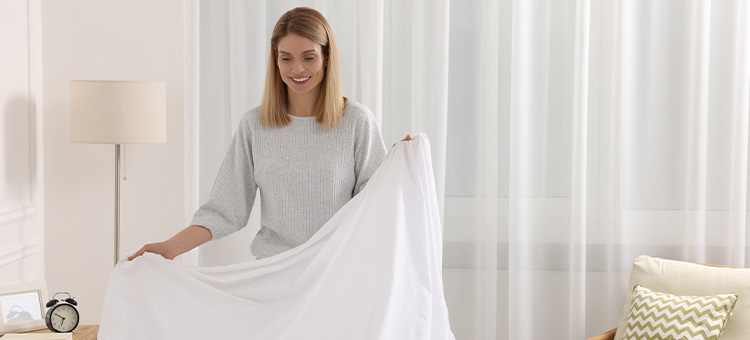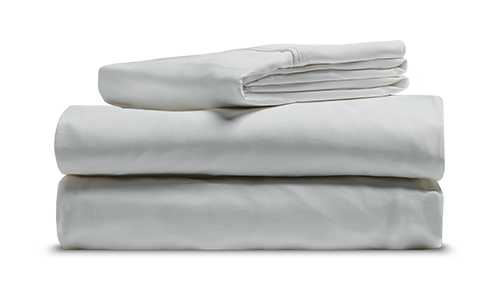
How to Fold a Fitted Sheet (2024)
We are owned and operated by GoodMorning.com. We hire 3rd-party engineers and use public data to rate mattresses on over 30 criteria that we believe are important. Brands we own—Douglas, Juno, Octave, Logan & Cove, and Novosbed—are reviewed and advertised where indicated. Views expressed here are our opinions only. Full details.
The fitted sheet—the piece of bedding we all dread taking out of the dryer. It’s a challenge to fold nicely, thanks to the elastic on the bottom edge. And when you need to store your fitted sheet, it’s very tempting just to crumple it into a ball, throw it into a closet, and forget about it. But crumpling your fitted sheet or folding it badly can lead to an overstuffed bedding shelf or basket, and wrinkled or damaged sheets.
But don’t worry. In this article, we’ll show you the easiest and most straightforward ways to fold fitted sheets, and stop you from pulling your hair out on laundry day. No matter the type or size of fitted sheet you have, once you try these folding methods, you’ll conquer the laundry basket with ease.
Method 1: The Tuck Method
Follow the steps below to learn how to fold fitted sheets in a clever way that stops the pesky elastic from giving you trouble.
- Grab your fitted sheet from the dryer or from its current crumpled-up state in your closet.
- Turn the sheet inside out (if it isn’t already) and lay the sheet on a clean, flat surface.
- Reach into each corner of the fitted sheet to smooth and flatten the edges. This will help you get crisp edges and a flatter fold.
- While standing up, take the long edge of the sheet and tuck your hands into the bottom corners. You should be able to see the corner seam on each hand.
- Touching the corner seams together, tuck one corner of the sheet over the other. You should now have one hand under two corners of the sheet, and one free hand.
- Use your free hand to shake out and straighten the bottom unfolded corners. Don’t be afraid to switch hands if you find that easier.
- While one hand is inside the sheet, move your free hand along the length of the fold until you reach the corners on the opposite side. The sheet should now be folded in half.
- With each hand in a corner of your half-folded fitted sheet, bring the two corner seams to touch once again, and make another tuck. You should be left with one free hand, and a hand that’s now under all four corners of the sheet.
- Again, move your hand along the length of the fold to smooth out the edges and corners. The sheet should now be folded in quarters.
- Lay down the sheet on your flat surface. The elastic band of your fitted sheet should form a “J” shape. Smooth out the sheet as needed.
- Fold your sheet into thirds, then in half again (or go for another fold if you want to reduce the final size even more).
And there you have it! A fitted sheet that will actually fit on your shelf.
For a faster fold: If you’re in a hurry, you can do a single tuck by stopping at step 5. Just lay the sheet on a flat surface, with the elastic forming a “U” shape. Fold your sheet in thirds horizontally, then vertically. You can fold your sheet smaller if you prefer. All done!
Method 2: The Flat Method
If you don’t like the idea of holding your fitted sheet up in the air, the flat method might be easier for you.
- Lay your fitted sheet on a clean, flat surface (like a bed or table) with the elastic facing up.
- Reach into each corner of the fitted sheet to smooth and flatten the edges. This will give you crisp edges and a flatter fold.
- Take the two top corners of your fitted sheet and fold them into the middle. Do the same with the bottom two corners, bringing them to meet the top half of the sheet in the middle. Smooth out the sides.
- Fold the shape you’ve created in half again, creating a rectangle shape with your fitted sheet. Once again, be sure to smooth out the sides.
- Fold the ends of your elongated rectangle into itself as many times as you’d like to achieve your desired final size—about 2–4 folds. Smooth the sides on the sheet one final time.
All done! Go ahead and admire your nicely folded fitted sheet.
Either of these methods will work well for folding other bedding items, too. However, if you’re folding your top sheet, duvet or duvet cover, or weighted blanket, you might prefer the flat method. Good luck!
ADVERTISEMENT

Douglas
100% Egyptian Cotton Sheets
Starting at $99
Quality bedding makes for quality sleep. Using long-staple cotton certified by the Cotton Egypt Association™, Douglas Egyptian Cotton sheets are breathable and have a silky-smooth feeling that lasts wash after wash. Try them with a 120-night sleep trial to see if they’re right for you.
ADVERTISEMENT
Why should I fold fitted bed sheets?
You should fold your fitted sheets for a few reasons.
- Folding your fitted sheet helps keep your extra bedding well-organized, and makes it easier to find what you’re looking for in your linen closet.
- Knowing how to fold the fitted sheet in your bedding set will also help prevent wrinkles while your bedding is not in use. A folded sheet will help preserve the sheet’s smooth look, without having to break out your iron.
- Folding your fitted sheet can help prevent damage to your bedding while it’s in storage. Loose ends and scrunched-up pieces of bedding are at higher risk of wear and tear or getting snagged.
Now you know how to fold a fitted sheet by yourself—congrats! The methods detailed in this article will help you to fold fitted sheets with ease, no matter which method suits you best. Your balled-up fitted sheets will thank you!


